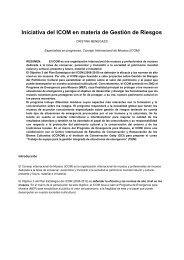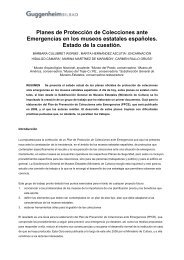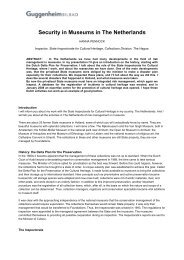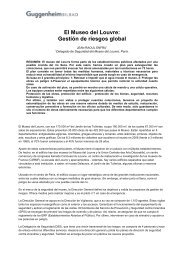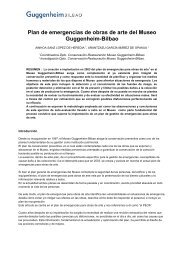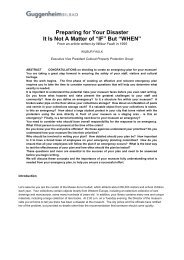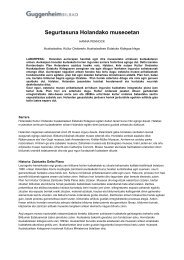Emergency plans in museums in Germany - Museo Guggenheim ...
Emergency plans in museums in Germany - Museo Guggenheim ...
Emergency plans in museums in Germany - Museo Guggenheim ...
You also want an ePaper? Increase the reach of your titles
YUMPU automatically turns print PDFs into web optimized ePapers that Google loves.
<strong>Emergency</strong> <strong>plans</strong> <strong>in</strong> <strong>museums</strong> <strong>in</strong> <strong>Germany</strong><br />
HANS-JÜRGEN HARRAS<br />
State Museums of Berl<strong>in</strong>.<br />
ABSTRACT: “It is fortunate that disasters do not occur every day <strong>in</strong> <strong>museums</strong> and galleries.<br />
The very rarity of them can lead to a situation where we hope for the best and are reluctant to<br />
prepare for the worst! Forethought and plann<strong>in</strong>g can prevent an emergency becom<strong>in</strong>g a disaster<br />
and m<strong>in</strong>imise the <strong>in</strong>jury and damage to people and collections.” (Bryan Dovey)<br />
Some <strong>museums</strong> <strong>in</strong> <strong>Germany</strong> have experienced disasters and damage - natural caused or human<br />
caused. The awareness is just grow<strong>in</strong>g that there can someth<strong>in</strong>g more be done to fulfil one of the<br />
most important functions of a museum – to preserve the cultural heritage.<br />
Flood, fire, theft, vandalism and other dangers threaten <strong>museums</strong>. The level of preparedness <strong>in</strong> the<br />
various <strong>museums</strong> is different from one to the other. There are some efforts to get the <strong>museums</strong> <strong>in</strong><br />
<strong>Germany</strong> together on the way to a higher level of security for the build<strong>in</strong>gs and collections.<br />
The flood <strong>in</strong> 2002 is one of the important <strong>in</strong>cidents that figured out a mighty natural threat – not<br />
only to <strong>museums</strong>. Someth<strong>in</strong>g has changed s<strong>in</strong>ce these horrible weeks. It is not only a task for<br />
<strong>museums</strong>, mostly for the whole regions. The collaboration with the local authorities and govern<strong>in</strong>g<br />
bodies has changed s<strong>in</strong>ce then.<br />
Another disaster was the fire <strong>in</strong> the Library of Anna Amalia <strong>in</strong> Weimar which destroyed a huge<br />
amount of valuable books and manuscripts.<br />
The State Museums of Berl<strong>in</strong> have their own experience with fire – <strong>in</strong> the Museum of Contemporary<br />
Arts - Hamburger Bahnhof. Also this case from 2003 is expla<strong>in</strong>ed <strong>in</strong> some details. It shows a better<br />
preparation aga<strong>in</strong>st the danger of fire and how it has worked.<br />
The daily threats of theft, <strong>in</strong>trusion and other human caused <strong>in</strong>cidents require also be<strong>in</strong>g prepared.<br />
The author expla<strong>in</strong>s some measures which help to reduce the risks, how to prepare for and to react<br />
<strong>in</strong> emergency situations.<br />
Introduction<br />
Let me start with a quotation. Bryan Dovey, a former Chairman of ICMS said once:<br />
“It is fortunate that disasters do not occur every day <strong>in</strong> <strong>museums</strong> and galleries. The very rarity of them can lead to a<br />
situation where we hope for the best and are reluctant to prepare for the worst! Forethought and plann<strong>in</strong>g can prevent<br />
an emergency becom<strong>in</strong>g a disaster and m<strong>in</strong>imise the <strong>in</strong>jury and damage to people and collections.”<br />
We f<strong>in</strong>d <strong>in</strong> <strong>Germany</strong> like <strong>in</strong> other European countries a lot of different types of <strong>museums</strong>: pa<strong>in</strong>t<strong>in</strong>g galleries, sculpture<br />
<strong>museums</strong>, <strong>museums</strong> of arts and craft, historical <strong>museums</strong>, archaeological <strong>museums</strong>, natural <strong>museums</strong>, <strong>museums</strong> of<br />
modern art, scientific <strong>museums</strong> and far more. These <strong>museums</strong> are located <strong>in</strong> historical museum build<strong>in</strong>gs – more and<br />
more of these build<strong>in</strong>gs are restored and renovated -, as well as <strong>in</strong> modern build<strong>in</strong>gs, <strong>in</strong> castles, fortresses and others.<br />
Like <strong>museums</strong> all over the world the <strong>museums</strong> <strong>in</strong> <strong>Germany</strong> do their daily work: The museum employees do their<br />
scientific research, restore collection objects, ma<strong>in</strong>ta<strong>in</strong> the permanent exhibitions, take care of the collections and<br />
visitors and create special exhibitions – often with a big success. Those special exhibitions attract a lot of visitors who<br />
want to see these exhibitions. Artworks can be seen there <strong>in</strong> completely new arrangements and comb<strong>in</strong>ations.<br />
Pa<strong>in</strong>t<strong>in</strong>gs, sculptures and other museum items have to travel for be<strong>in</strong>g exhibited <strong>in</strong> special exhibitions <strong>in</strong> other<br />
<strong>museums</strong>. To give a lot of loans to <strong>museums</strong> all over the world is a daily task. But it is also a threat to the museum<br />
items. Let me po<strong>in</strong>t out some more threats:<br />
A lot of activities are organised <strong>in</strong> and around <strong>museums</strong>: concerts, operas, meet<strong>in</strong>gs, d<strong>in</strong>ner parties, sometimes without<br />
a connection to the museum and its collection, only to have the party on a special and unusual location. Those events<br />
gather many people for a short time <strong>in</strong> a limited space. The preparation for these events needs mostly much more time<br />
than the event itself. Special lightn<strong>in</strong>g must be prepared, mobile stages have to be build, the caterer prepares food and<br />
dr<strong>in</strong>ks which have to be served dur<strong>in</strong>g the event and there is never enough time to do all these th<strong>in</strong>gs <strong>in</strong> a calm way.<br />
Doors <strong>in</strong> the museum have to stay open because electrical cables have to lie across. Fast runn<strong>in</strong>g ways for the waiters<br />
have to be free for them and others. But these are not the only threats to the museum items <strong>in</strong>side of the build<strong>in</strong>g.
Sometimes visitors of events like mentioned before change their behaviour after hav<strong>in</strong>g some alcoholic dr<strong>in</strong>ks and that<br />
is not every time an advantage for the museum.<br />
Museums are often located <strong>in</strong> historical build<strong>in</strong>gs, others <strong>in</strong> modern build<strong>in</strong>gs. All k<strong>in</strong>d of museum build<strong>in</strong>gs have to be<br />
ma<strong>in</strong>ta<strong>in</strong>ed with different k<strong>in</strong>d of measures, small and big. Renovation and restoration work <strong>in</strong> a museum while it runs <strong>in</strong><br />
the same time <strong>in</strong> the build<strong>in</strong>g its exhibition, its storages and workshops needs a lot of measures to guarantee the level<br />
of security. You can f<strong>in</strong>d often surpris<strong>in</strong>gly new ways <strong>in</strong>to the museum over the scaffold on the outside of the build<strong>in</strong>g.<br />
Weld<strong>in</strong>g requires special monitor<strong>in</strong>g of the workplace and the surround<strong>in</strong>gs. Escape ways can be closed dur<strong>in</strong>g the<br />
ma<strong>in</strong>tenance work. The fire brigade or other helpers f<strong>in</strong>d an unusual situation <strong>in</strong> and around the museum <strong>in</strong> case of a<br />
fire alarm or <strong>in</strong> another emergency situation. There are visitors every day <strong>in</strong> the exhibitions <strong>in</strong> the <strong>museums</strong>. The most<br />
of them wants to see the exhibition, to rejoice themselves <strong>in</strong> the pa<strong>in</strong>t<strong>in</strong>gs, sculptures, <strong>in</strong>stallations and other items.<br />
Some visitors are also <strong>in</strong>terested <strong>in</strong> th<strong>in</strong>gs beh<strong>in</strong>d the scene. But unfortunately those <strong>in</strong>terests can cause damages.<br />
Luckily there is mostly not a bad <strong>in</strong>tention beh<strong>in</strong>d the <strong>in</strong>terest.<br />
On the other hand there are also – luckily seldom - other visitors who are go<strong>in</strong>g to damage exhibited items or who want<br />
to steal someth<strong>in</strong>g from the museum. If we look <strong>in</strong>to the history of <strong>museums</strong> we f<strong>in</strong>d many cases of attacks aga<strong>in</strong>st<br />
exhibited items. Pa<strong>in</strong>t<strong>in</strong>gs were destroyed with knifes or attacked with acid. Other items were stolen dur<strong>in</strong>g the night<br />
hours or taken away dur<strong>in</strong>g an armed robbery. To mention some examples from <strong>Germany</strong> and from other countries: I<br />
am sure you remember the <strong>in</strong>trusion <strong>in</strong>to the Kunsthistorisches Museum Wien, when the famous salt pot called<br />
“Saliera” by Cell<strong>in</strong>i was stolen dur<strong>in</strong>g the night. The thief entered the upper level of the museum over the scaffold on the<br />
facade of the museum which was not properly protected. He smashed and opened a w<strong>in</strong>dow of the showroom and<br />
destroyed the showcase <strong>in</strong> the exhibition room. Do<strong>in</strong>g this he triggered an alarm on the <strong>in</strong>trusion alarm system but the<br />
guards thought that it was a false alarm and didn’t react as they had to do. The result was that the thief escaped<br />
undiscovered. Fortunately the stolen Saliera was found after some month and returned to the Kunsthistorisches<br />
Museum.<br />
The Munch museum <strong>in</strong> Oslo experienced a more dangerous case <strong>in</strong> the summer 2004. Two pa<strong>in</strong>t<strong>in</strong>gs were stolen<br />
dur<strong>in</strong>g the open<strong>in</strong>g hours by some gunmen. The police arrested some suspicious people after that and took lots of<br />
<strong>in</strong>vestigation but it needed very long until the pa<strong>in</strong>t<strong>in</strong>gs were found <strong>in</strong> August 2006. The famous pa<strong>in</strong>t<strong>in</strong>g “The Scream”<br />
was so badly damaged that it is not possible to restore it.<br />
Stolen objects return mostly to the museum. The amount of stolen objects is small compared to the amount of objects<br />
of the collection as a whole. So from my po<strong>in</strong>t of view there are much more dangerous hazards for <strong>museums</strong> and<br />
collections than robberies and thefts: Fire and flood, which can destroy a big amount of museum objects <strong>in</strong> a short time.<br />
And burnt objects can’t return to a collection. May be they can get replaced with a copy, a second issue or anyth<strong>in</strong>g<br />
similar. But the orig<strong>in</strong>al which is burned is away with all its <strong>in</strong>formation, its history, its secrets and aura.<br />
The Anna-Amalia-Library <strong>in</strong> Weimar was burnt by a really big and destructive fire which started <strong>in</strong> the even<strong>in</strong>g hours of<br />
2nd September 2004. A big part of the collection of books and pa<strong>in</strong>t<strong>in</strong>gs got lost by the flames. Another part was<br />
damaged by the fire and ext<strong>in</strong>guish<strong>in</strong>g water. Around 50.000 books from the 17th and 18th century were burnt, also 35<br />
pa<strong>in</strong>t<strong>in</strong>gs from the 16th – 18th century. 62.000 books were saved, a lot of them partially damaged. Many employees<br />
and others came to help <strong>in</strong> that bad situation. The fire brigade needed actually five days till the fire was completely<br />
ext<strong>in</strong>guished. The fire was probably caused by a defective electrical <strong>in</strong>stallation. The wooden build<strong>in</strong>g construction and<br />
the wooden <strong>in</strong>terior, the galleries and the stairs between the galleries accelerated the spread of fire. The fire brigade<br />
wasn’t able to get close to the fire because of the enormous heat. They could only fight the fire from the distance for<br />
long time. Irony of history: Without the fire it was planned to start with the restoration of the build<strong>in</strong>g five weeks later.<br />
The plann<strong>in</strong>g eng<strong>in</strong>eer had proposed an automatically ext<strong>in</strong>guish<strong>in</strong>g system but he didn’t get enough acceptances for<br />
his proposal before the fire. These op<strong>in</strong>ions were completely changed after the fire.<br />
Austria, Czech Republic and <strong>Germany</strong> were affected <strong>in</strong> 2002 by heavy ra<strong>in</strong> falls <strong>in</strong> the mounta<strong>in</strong>s and consequently<br />
there were big damages from a flood which has never been seen for more than hundred years. The famous Dresdner<br />
Zw<strong>in</strong>ger, the State Art Collections <strong>in</strong> Dresden located <strong>in</strong> the middle of the town and close to the river Elbe were under<br />
water. Pa<strong>in</strong>t<strong>in</strong>gs and sculptures from storages <strong>in</strong> the underground floor had to be evacuated <strong>in</strong> very few hours. There<br />
was not enough help from the authorities <strong>in</strong> the first hours. Hospitals and other build<strong>in</strong>gs where human life was <strong>in</strong><br />
danger were more important. But a lot of employees of the State Art Collection were alarmed. Employees of the<br />
M<strong>in</strong>istry for Art and Science <strong>in</strong> the neighbourhood came to help. 23.000 objects were moved <strong>in</strong> very short time and<br />
these 23.000 objects were saved. All the pa<strong>in</strong>t<strong>in</strong>gs could be evacuated from the underground floor to the upper levels<br />
<strong>in</strong>to the exhibition halls.<br />
Only six of them which were too big for the rema<strong>in</strong><strong>in</strong>g transport ways had to stay there. Like five rolled pa<strong>in</strong>t<strong>in</strong>gs they<br />
were hanged under the ceil<strong>in</strong>g of the cellar floor. This was good enough to keep them away from the water for the<br />
whole flood. The smaller damage of the pa<strong>in</strong>t<strong>in</strong>gs from this situation could be fixed after that. But many other objects
like around 50 baroque frames, build<strong>in</strong>g <strong>in</strong>terior, mach<strong>in</strong>es and technical systems <strong>in</strong> the underground floor were<br />
damaged or completely destroyed. The THW (Technisches Hilfswerk) gave a lot of support with hydraulic pumps to<br />
lower the level of water <strong>in</strong>side of the museum build<strong>in</strong>gs. Soldiers of the Bundeswehr protected the build<strong>in</strong>gs as long as<br />
the <strong>in</strong>trusion detection system was out of order. The spontaneous collaboration of a lot of people led to a very good<br />
result. The <strong>museums</strong> <strong>in</strong> <strong>Germany</strong> and other cultural <strong>in</strong>stitutions learned an important lesson from this case: You cannot<br />
do everyth<strong>in</strong>g by yourself <strong>in</strong> natural caused case of emergency. You need the right network, connections to all those<br />
who are able to help and assist you. That means connections to other local cultural <strong>in</strong>stitutions as well as the local<br />
authorities, the army, companies with helpful equipment and many more. Museums, libraries, archives and similar<br />
<strong>in</strong>stitutions which house a lot of objects of history, culture and art have the same problems. If they collaborate with each<br />
other they can achieve much more success than alone. They can share a lot of facilities like additional storage <strong>in</strong> a<br />
climate controlled state. Transport capacities, people who know how to handle sensitive objects of art can get together<br />
<strong>in</strong> the place of emergency.<br />
Skilled workers like restorers exchange their experiences: What can be done <strong>in</strong> which case, which methods could be<br />
helpful just now. The connection to local authorities, to the fire brigade, the police, the universities and others plays an<br />
important role. The responsible employees of those <strong>in</strong>stitutions can get familiar with the situation <strong>in</strong> the museum, library<br />
or archive before an emergency. It is much easier to f<strong>in</strong>d the right decisions <strong>in</strong> case of emergency if they know about<br />
the circumstances of the collections, of the build<strong>in</strong>g, about how to handle works of art properly. It is very helpful to tra<strong>in</strong><br />
situations which can lead to disaster before such situations become real. It can be pa<strong>in</strong>ful and exhaust<strong>in</strong>g but it will be<br />
helpful if one needs these experiences. Nobody knows before when a disaster will happen. The simulation of possible<br />
solutions aga<strong>in</strong>st the <strong>in</strong>fluence of such enormous amounts of water <strong>in</strong> Dresden and other cities of the flooded areas<br />
lead to a lot of protective solutions like new walls, water barriers, renaturisation of land zones which can be used for<br />
be<strong>in</strong>g flooded to give the water a def<strong>in</strong>ed way and area to reduce the destructive power of the water.<br />
The Konferenz Nationaler Kulture<strong>in</strong>richtungen <strong>in</strong> <strong>Germany</strong>, a collaboration of important cultural <strong>in</strong>stitutions arranged<br />
some meet<strong>in</strong>gs <strong>in</strong> recent years to the ma<strong>in</strong> objective of security, prevention and emergency plann<strong>in</strong>g. A lot of <strong>museums</strong><br />
attended these meet<strong>in</strong>gs and consequently the emergency plann<strong>in</strong>g <strong>in</strong> many cultural <strong>in</strong>stitutions got a good progress.<br />
Some publications were issued by the organizers with guidel<strong>in</strong>es for possible measures aga<strong>in</strong>st various threats,<br />
conta<strong>in</strong><strong>in</strong>g also a bibliography and contact details of specialists <strong>in</strong> the different fields of security and prevention. I see it<br />
as some first steps <strong>in</strong> the right direction. But from my po<strong>in</strong>t of view it would be necessary to concentrate such issues <strong>in</strong><br />
a centralised <strong>in</strong>stitution. It is not as easy as it seems because culture is <strong>in</strong> <strong>Germany</strong> a task <strong>in</strong> the sovereignty of the<br />
federal states.<br />
The “Association for loss prevention” VdS <strong>in</strong> <strong>Germany</strong> has published a guidel<strong>in</strong>e for the generation of <strong>plans</strong> for<br />
evacuation and rescue of art and cultural objects – VdS 3434. The aim of the guidel<strong>in</strong>e is to help to create suitable<br />
emergency <strong>plans</strong> for the various cultural <strong>in</strong>stitutions. Panic, helplessness and chaos should be avoided by hav<strong>in</strong>g a<br />
plan what to do to give a structure to the necessary activities. The emergency plan has to cover the measures of the<br />
first 48 hours after an emergency. The field of application for the guidel<strong>in</strong>e are all those <strong>in</strong>stitutions like <strong>museums</strong>,<br />
libraries, archives, churches, galleries, art depositories and others. What do these <strong>in</strong>stitutions have <strong>in</strong> common?:<br />
They house mostly unrecoverable collections of assets with a very high value. The collections and items have a high<br />
sensitivity to external <strong>in</strong>fluences like light, humidity, temperature and others. Those <strong>in</strong>fluences come together every<br />
time with the hazards of an emergency. They endanger the items and objects of the collections. We f<strong>in</strong>d a lot of curious<br />
guests on the fences around the locations of emergency. It could be possible that there were also some suspicious<br />
person among them. It is not possible to watch and monitor them all dur<strong>in</strong>g their movement around the place or<br />
build<strong>in</strong>g.<br />
The guidel<strong>in</strong>e VdS 3434 recommends specific measures before an emergency:<br />
Do a risk assessment for your museum. F<strong>in</strong>d the weak po<strong>in</strong>ts <strong>in</strong> constructive and physical matters, <strong>in</strong> organisational<br />
matters and others. Then improve at first the constructive conditions <strong>in</strong> your build<strong>in</strong>g to m<strong>in</strong>imize risks. What can be<br />
done: For example: Make the doors and w<strong>in</strong>dows stronger that they are resistant aga<strong>in</strong>st attacks. Divide the build<strong>in</strong>g<br />
<strong>in</strong>to fire compartments or smoke fight<strong>in</strong>g compartments. Then <strong>in</strong>stall technical systems which could recognise hazards:<br />
A fire alarm system, an <strong>in</strong>trusion alarm system, a video surveillance system and others. Make sure that a hazard can<br />
be recognised very early - before it causes a bigger damage and before the constructive devices get destroyed which<br />
give the real protection. Organisational measures have to guarantee that an alarm which has been triggered on the<br />
technical systems can reach the right recipient, a guard or anyone else who is able to react <strong>in</strong> appropriate time and<br />
appropriate way, who knows what to do, who can organise the proper counteraction. Procedure <strong>in</strong>structions should be<br />
written <strong>in</strong> an emergency plan.<br />
Who has to be alerted? Members of museum staff, fire brigade, police, the director of the collection. Because the<br />
guards can get overstra<strong>in</strong>ed with such a situation we have <strong>in</strong> the State Museums of Berl<strong>in</strong> a call-on duty around the
clock for members of the security management. They will be alerted also as soon as possible by mobile phone, can<br />
give support at first on the phone and have to hurry to the place of emergency to take the lead.<br />
Dur<strong>in</strong>g open<strong>in</strong>g hours of the museum: Visitors have to be evacuated, museum staff too. Guards <strong>in</strong> the exhibition halls<br />
have to guide the visitors to the escape ways and have to care <strong>in</strong> the same time for the security of the exhibited<br />
objects. Panic has to be avoided. Handicapped persons have to get supported.<br />
Depend<strong>in</strong>g on the hazard and situation the fire brigade and police got already automatically alerted (by direct l<strong>in</strong>e of the<br />
fire alarm system for example). When they arrive to the museum they have to f<strong>in</strong>d a responsible person who can give<br />
them the necessary <strong>in</strong>formation about what has happened, where are the ways to enter the build<strong>in</strong>g to f<strong>in</strong>d an easy<br />
way to the location of the hazard. There has to be a special key which opens all locks of the doors for the fire brigade.<br />
A map of the build<strong>in</strong>g and its surround<strong>in</strong>gs with <strong>in</strong>formation about doors, water supply, electrical supply, dangerous<br />
devices like workshops with poisonous liquids, electrical ma<strong>in</strong> distribution boards and more has to be handed over. Fire<br />
<strong>plans</strong> for all floors of the build<strong>in</strong>g are helpful too. Such <strong>plans</strong> can <strong>in</strong>clude <strong>in</strong>formation about the content of the rooms<br />
(sensitive museum objects, exhibition rooms and others). It can help the fire brigade or others to be as careful as<br />
possible and to m<strong>in</strong>imize the damage of objects. The priority of objects which could be evacuated can be signed <strong>in</strong><br />
such <strong>plans</strong> for permanent exhibitions. This is not really possible for temporarily exhibitions. I know how difficult it is for<br />
curators of collections to set a priority for art items. Every object is important for the museum. But the fire brigade is not<br />
able to decide <strong>in</strong> case of fire. They need a decision before.<br />
In the case of evacuation it is absolutely necessary to make documentations about what is evacuated, where it is<br />
stored now, best with photos and written notations. It is helpful to contact the <strong>in</strong>surance company as soon as possible.<br />
The <strong>in</strong>surance companies have specialists who can give a valuable support <strong>in</strong> emergency cases. After the emergency:<br />
An analysis of harmful substances which can damage the rescued objects or the objects which rema<strong>in</strong>ed <strong>in</strong> the build<strong>in</strong>g<br />
should be done as soon as possible to avoid further damage. We have some very helpful collaboration <strong>in</strong> groups of<br />
specialists like restorers from <strong>museums</strong> <strong>in</strong> the neighbourhood for emergency cases. Lists with phone numbers of those<br />
specialists get updated every half year. Security for objects – rescued or rema<strong>in</strong>ed <strong>in</strong> their place – has to be organised<br />
or <strong>in</strong>stalled, constructive measures as well as security patrols or <strong>in</strong>terim storage facilities. Teamwork with <strong>in</strong>surance<br />
company, local authorities and specialists from the museum staff is required for the cont<strong>in</strong>uation of rescue, preservation<br />
and restoration. Communication to public media has to be done through only one l<strong>in</strong>e. All <strong>in</strong>quiries from journalists,<br />
broadcast and television service have to be answered from one dedicated spokesman, not from others. Otherwise<br />
there will arise lots of rumours and presumptions.<br />
I am go<strong>in</strong>g to give you a report about a fire <strong>in</strong> one of our <strong>museums</strong>. It happened <strong>in</strong> the Museum of Contemporary Art<br />
Berl<strong>in</strong> – Hamburger Bahnhof on 27th July 2003. An alarm from a motion detector of the <strong>in</strong>trusion alarm system <strong>in</strong> an<br />
exhibition room was triggered at 7.45 p.m. A smoke detector <strong>in</strong> the same exhibition room triggered an alarm some<br />
moments later. The fire brigade was automatically alerted and arrived 6 m<strong>in</strong>utes later. The smoke vent of the room was<br />
opened already. Lots of smoke came out of it. An LED on a display <strong>in</strong> the security control room po<strong>in</strong>ted out the floor<br />
and the area of the build<strong>in</strong>g where the fire alarm was triggered. A card which displayed the way from the security<br />
control room to the location of fire, appropriate to the number of the smoke detector, was handed over to the fire<br />
brigade. Fortunately the museum build<strong>in</strong>g was equipped with modern fire resistant facilities like automatically clos<strong>in</strong>g<br />
fire resistant doors. These doors were part of the boundaries of the fire compartment. They got closed automatically<br />
when the fire detection system triggered an alarm. Some artworks of modern art were exhibited <strong>in</strong> the affected part of<br />
the museum. In this case it was a room-<strong>in</strong>-room <strong>in</strong>stallation there, covered with an <strong>in</strong>ner ceil<strong>in</strong>g. Some passage ways<br />
between the exhibition halls were closed from this <strong>in</strong>stallation. I show you some views of the artwork taken of a former<br />
<strong>in</strong>stallation of this artwork. Other than shown here the candles were not lit <strong>in</strong> our exhibition. The fire started <strong>in</strong>side of the<br />
<strong>in</strong>stallation room.<br />
Because of the ceil<strong>in</strong>g of the <strong>in</strong>stallation the smoke couldn’t get out and couldn’t reach the smoke detector. One of the<br />
walls of the <strong>in</strong>stalled room broke down – that was the <strong>in</strong>trusion alarm – and then the smoke came out and triggered the<br />
fire alarm on the smoke detector. In this time it was not a small fire anymore. Lots of smoke came out of the fire and<br />
filled the rooms of the fire compartment. It didn’t last very long but the impact of smoke was really visible <strong>in</strong> all the<br />
neighbour<strong>in</strong>g rooms. The guards had alerted many people of the museum staff, the security department, the director<br />
and the spokesman. So it was possible that nearly all of the objects from the exhibition <strong>in</strong> the neighbour<strong>in</strong>g rooms could<br />
be rescued very fast. These objects were carried <strong>in</strong>to the next fire compartments <strong>in</strong> the same museum build<strong>in</strong>g. There<br />
were the same climate conditions and the <strong>in</strong>trusion detection system and fire detection system was still work<strong>in</strong>g there.<br />
The analysis and restoration for these objects could start very fast. The damage of the facilities <strong>in</strong> the affected fire<br />
compartment is shown <strong>in</strong> the next pictures: There are the rema<strong>in</strong><strong>in</strong>g rests of the motion detector which triggered the<br />
first alarm, also the melted rest of the smoke detector above the room <strong>in</strong>stallation. The glass ceil<strong>in</strong>g with artificial<br />
lightn<strong>in</strong>g was completely destroyed. Parts of the glass panes rema<strong>in</strong>ed <strong>in</strong> the ceil<strong>in</strong>g construction <strong>in</strong> a very dangerous<br />
way – like a guillot<strong>in</strong>e. Also the glass ceil<strong>in</strong>gs <strong>in</strong> the neighbour<strong>in</strong>g rooms were damaged from the hot smoke. The room<br />
without the <strong>in</strong>stallation on the next day showed a lot of damage. Luckily the fire brigade used a method to foam up the
ext<strong>in</strong>guish<strong>in</strong>g water with compressed air. So they didn’t need a lot of water and the damage for the <strong>museums</strong> build<strong>in</strong>g<br />
caused by water was small. The police and the fire brigade searched for long times for the reason of the fire but it<br />
rema<strong>in</strong>ed unsolved.
Conclusion<br />
What I can recommend <strong>in</strong> summary from my experiences is the follow<strong>in</strong>g:<br />
- Take <strong>in</strong> account that unexpected and unwanted events can happen every time.<br />
- Be prepared to react immediately <strong>in</strong> the case of emergency.<br />
- Tra<strong>in</strong> the necessary measures for emergencies with your staff.<br />
- Look for communication and collaboration with local partners <strong>in</strong> time.<br />
- Prevention is the most important challenge.<br />
About the author<br />
He was born on 4 th April 1957 <strong>in</strong> Dömitz, <strong>Germany</strong>. After school and service <strong>in</strong> the army he studied communications<br />
eng<strong>in</strong>eer<strong>in</strong>g, f<strong>in</strong>ished as diploma eng<strong>in</strong>eer.<br />
He worked as development eng<strong>in</strong>eer for some years <strong>in</strong> various companies. He started a job 1990 <strong>in</strong> a company which<br />
<strong>in</strong>stalled security systems (Ristow GmbH). He was the head of the Berl<strong>in</strong> office for four years. Dur<strong>in</strong>g this time he was<br />
<strong>in</strong>volved <strong>in</strong> the <strong>in</strong>stallation a lot of security systems <strong>in</strong> <strong>museums</strong> <strong>in</strong> Berl<strong>in</strong>. So he was able to collect many experiences<br />
of the specialised requirements <strong>in</strong> <strong>museums</strong>. The company was sold 1993 to Cerberus, Switzerland.<br />
He started his job as Head of Security <strong>in</strong> the State Museums of Berl<strong>in</strong> – Foundation of Cultural Property of the former<br />
State Prussia <strong>in</strong> 1995. He is responsible here <strong>in</strong> sixteen of the biggest <strong>museums</strong> <strong>in</strong> Berl<strong>in</strong> for the security systems and<br />
for the guards <strong>in</strong> the exhibition halls and guards who monitor the build<strong>in</strong>gs. He also provides support to other<br />
professionals as an advisor <strong>in</strong> questions of security from other <strong>museums</strong>, especially <strong>in</strong> <strong>Germany</strong>.<br />
He became a member of ICMS/ICOM 1997 while the annual meet<strong>in</strong>g was held <strong>in</strong> Berl<strong>in</strong>. He was later elected as an<br />
ord<strong>in</strong>ary ICMS Board member 2001, started as Secretary of ICMS 2003 and was elected as ICMS Chair <strong>in</strong> 2007. He is<br />
also active as the Head of the Vocabulary Work<strong>in</strong>g Group of ICMS.<br />
Hans-Jürgen Harras<br />
Staatliche Musen Berl<strong>in</strong><br />
Referat Sicherheit<br />
Tel.:0049-30-266 2900 / Fax:0049-30-266 2969<br />
Email: h.j.harras@smb.spk-berl<strong>in</strong>.de


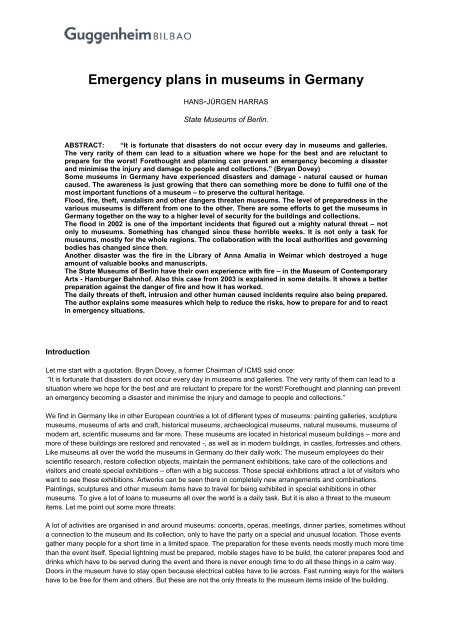
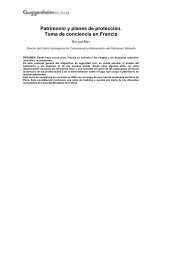
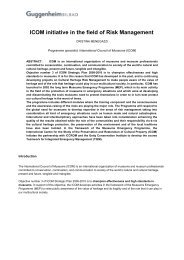
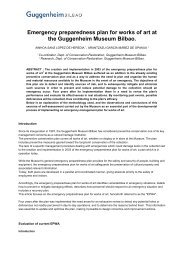
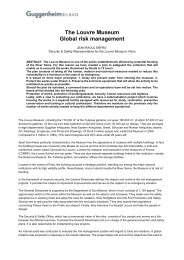
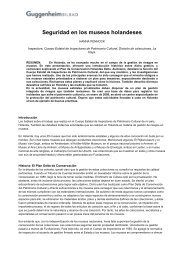
![Planes de emergencia en los museos de Alemania. [PDF - 103.91 Kb]](https://img.yumpu.com/22117472/1/184x260/planes-de-emergencia-en-los-museos-de-alemania-pdf-10391-kb.jpg?quality=85)

